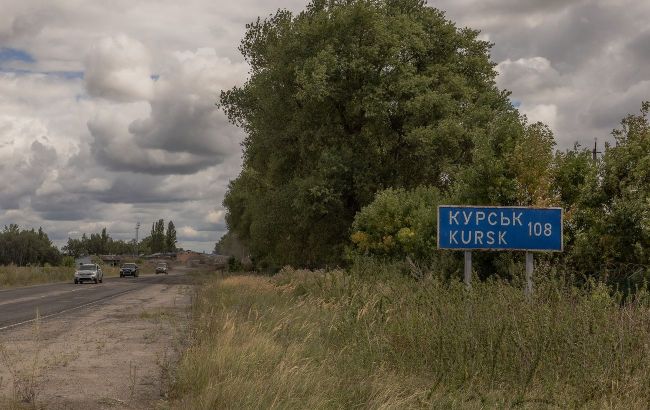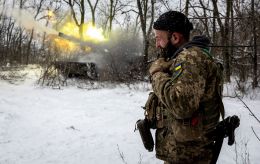Kursk operation and Pokrovsk direction: Analysis by US General Ben Hodges
 Sign for Kursk in the Sumy region (photo: Getty Images)
Sign for Kursk in the Sumy region (photo: Getty Images)
Retired American general and former commander of US Army Europe, Ben Hodges, explained the objectives of the Ukrainian Armed Forces' operation in the Kursk region, Russia's reaction to it, and the situation in the Pokrovsk direction.
I’ve been thinking about this UAF (Ukrainian Armed Forces) operation the last couple of weeks, and so I’ve tried to put it on "paper" to make sense of it.
First of all, what do we call this Ukrainian operation in the Kursk direction? Incursion sounds totally inadequate. Invasion is misleading. I consider it a counter-offensive based on what effects I see it achieving and based on what I think the Ukrainians are attempting to do. I don’t know this, of course, and I’m not entitled to know. But I think that, based on what I see, there are three objectives of this counter-offensive:
1. Сreate a bridgehead on the Russian side of the border that will
(a) deny a large part of territory...heretofore "sanctuary"...for Russian drone and rocket launches against Ukrainian cities;
(b) threaten/disrupt Russian oil/gas/nuclear power generation and infrastructure in Kursk Oblast;
(c) enable the Ukrainians to move their own long-range weapons further into Russia to strike Russian airfields, oil and gas infrastructure, and transportation infrastructure despite US and UK, and DEU restrictions on use of long-range weapons we’ve provided.
I’ve been trying to understand the Russian reactions to the Ukrainian Kursk counter-offensive. The apparent lack, thus far after two plus weeks, of appreciable impacts on Russian operations in the East resulting from the Ukrainian Kursk Counter-Offensive may be attributable to several factors.
2. Change the momentum and narrative about this war. It destroys the myth of a stalemate and inevitability of Russian victory, shows/reveals the many vulnerabilities on the Russian side in terms of Command and Control, logistics, and drone supremacy. How did the UAF achieve such amazing surprise despite Russia having so many drones? We need to learn how the UAF has created some sort of counter-drone capabilities that degrade Russian surveillance.
3. Draw off Russian forces from other places to deal with the Kursk bridgehead. I don’t know that this is a key objective for the UAF General Staff. In fact, they may be content to let their forces out defending the Pokrovsk area.
What follows is my assessment of the Russian reaction
There certainly is a determined focus by the Russian General Staff on their own offensive in the direction of Pokrovsk and Toretsk. They could be doing what their grandfathers did 80 years ago, allowing some penetrations in other parts of the Front, waiting for an opportunity to strike later. But I don’t think they have the competence or resources of their grandfathers. And many of the best Soviet troops were, of course, Ukrainian.
But I think the Kremlin’s response is also a reflection of the confused, ineffective Russian Command and Control setup. The General Staff is, I believe, running operations in the East. But the Kremlin put the FSB in charge of dealing with the Ukrainian “terrorist operation” in Kursk. I don’t think conducting large-scale operations is a core competency of FSB, as demonstrated two and a half years ago. So, a mix of FSB, General Staff, Rosgvardiya (The National Guard of the Russian Federation), and MOI/Border Forces is not an ideal C2 structure. And, as with the rivalries and hatreds made clear during Prigozhin's mutiny earlier in the War, I don’t imagine that the General Staff is in a hurry to divert forces to help FSB leadership.
And I think it’s also a matter of logistics – available transport to shift meaningful capabilities over reliable transportation networks for a distance of 700+ KM. Diverting land forces is much slower and more cumbersome than diverting air power.
Using my iPhone GPS, it is about 550 KM from Pokrovsk to Sudzha on the fastest land route (driving), going through UAF-controlled territory, including Kharkiv. Clearly, this is not a route available to Russian forces. Unfortunately, I don’t have a good way to quickly find out the rail transport routes available to Russian forces to divert troops from their eastern operations to Kursk. I would imagine a land route would be well over 700 km. In my own experience, we were constantly short of truck transport when I was a Brigade Commander in the 101st Airborne Division. The point is that nobody, even the Russians, has enough trucks for large movements on short notice.
Marshaling enough trucks and trains, on short notice, to move sizeable forces from eastern Ukraine to Kursk will take several days, if not weeks, once some HQ with the authority to direct it has come to the realization that it is necessary. I imagine it’ll be at least another week before we start to see impacts on Russian operations in the East.
Assessment of Russian operations in the Pokrovsk direction
Despite the endless hand-wringing in Western media about Russian operations in the Prokrovsk direction, I think the Ukrainian General Staff are, correctly, less concerned about this than many observers in the West.
It is about 50KM from Avdivka to Pokrovsk. Russia captured Avdivka back in February. I remember the gasps during the last Munich Security Conference back in February when this happened...people acted as if this was Stalingrad which had finally fallen.
So over the course of the last six months, during which time US ammunition deliveries had largely ceased, Russian forces have moved forward only about 50KM to the outskirts of Prokrovsk, at the cost of nearly 1K killed per day. Not exactly the fast-moving strikes of Marshall Zhukov.
It seems to me that the Ukrainian General Staff has correctly decided this defense of the Pokrovsk region must be a secondary effort, an economy of force because they see that the Russians cannot overrun Ukraine’s defenses, only attempt to gradually erode them.
While this puts enormous strain on Ukrainian Soldiers, Leaders, and their logistics, calculating risks and making these sorts of prioritization decisions is the hard, necessary work of the General Staff of Ukraine is ultimately to defeat Russia.
This allows the Ukrainian General Staff and GUR (Defense Intelligence) to focus on the highest priority operations and targets: Kursk counter-offensive, deep precision strikes against airfields and oil and gas infrastructure, ferries etc. They are conducting effective Ukrainian-style multi-domain operations (air, land, sea, cyber, info, SOF).
I would love to sit in on one of the General Staff and/or GUR targeting/synch meetings. It may not look like one of ours. But clearly, they are going through a very effective process to select and prioritize targets and weapons for those targets, running the counteroffensive, ensuring the logistics for all of this as best they can, protecting their LOCs and rear areas, trying to protect their cities and infrastructure, chasing off the Black Sea Fleet, and conducting effective info operations all at the same time…Despite not yet having fully established their “institutional army” (for recruiting and training, and education) and while the West continues to fall well short of adequately supporting Ukraine to defeat Russia.
Translated by Kateryna Shkarlat

